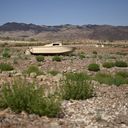Over half of the world's lakes are drying out, study warns

More than half of the world's largest lakes and reservoirs are losing water — and climate change and human consumption are the main drivers, a new large-scale study warns.
Why it matters: About one-quarter of the world's population, or 2 billion people, lives in the basin of a drying lake, per the study published in the journal Science Thursday. Water insecurity is already an issue, with hundreds of millions of people around the world lacking reliable access to safe water.
- The findings underscore an urgent need to incorporate climate change and sedimentation impacts into sustainable water resources management "to protect essential ecosystem services such as freshwater storage, food supply, waterbird habitat, cycling of pollutants and nutrients, and recreation," according to an editor's summary accompanying the study.
What they did: The team of international researchers looked at 250,000 lake-area satellite images taken from 1992 until 2020 to examine the area and water levels of 1,972 freshwater bodies.
What they found: 53% of lakes globally experienced a drop in water storage during that period — a water loss equivalent in volume to 17 Lake Meads, the largest reservoir in the U.S., according to the study.
- "The net volume loss in natural lakes is largely attributable to climate warming, increasing evaporative demand, and human water consumption, whereas sedimentation dominates storage losses in reservoirs."
Between the lines: Climate change is increasing the odds and severity of droughts, which tend to be hotter as the climate warms — increasing evaporation and worsening drought severity, per Axios' Andrew Freedman.
- Studies show climate change is increasing extreme weather swings from drought to flood and back again.
Of note: "This is the first comprehensive assessment of trends and drivers of global lake water storage variability based on an array of satellites and models," said study lead author Fangfang Yao, a CIRES visiting fellow, now a climate fellow at University of Virginia, in a statement issued by the University of Colorado Boulder.
State of play: The situation along the drought-stricken Colorado River in the U.S. has been dire in recent years with Lake Mead and Lake Powell, the second-largest reservoir in the country, plummeting to historic lows.
- Water levels in the lakes have risen in recent weeks due to the melting of the record snowpack in the U.S. West, enabling the U.S. Bureau of Reclamation to release more water from Lake Powell into Lake Mead, which provides water to some 25 million people across the Southwest.
- However, experts warn this reprieve is "limited and temporary" and that Lake Powell is predicted to increase to just 30% capacity by the fall, according to the Washington Post.
What they're saying: "A thorough understanding of water supply drivers is critical to effectively managing reservoirs and river systems," said Bart Leeflang, the Colorado River program manager for the Central Utah Water Conservancy District, who wasn't involved in the study, per WashPost.
- "The better we understand anthropogenic affects on our water supply, the better prepared we as water managers will be," he added.
- "We will face fewer crises, like we have been facing on the Colorado River over the last 20 years, and we will have resilient and reliable water supplies."
Go deeper: Future of food production hinges on water